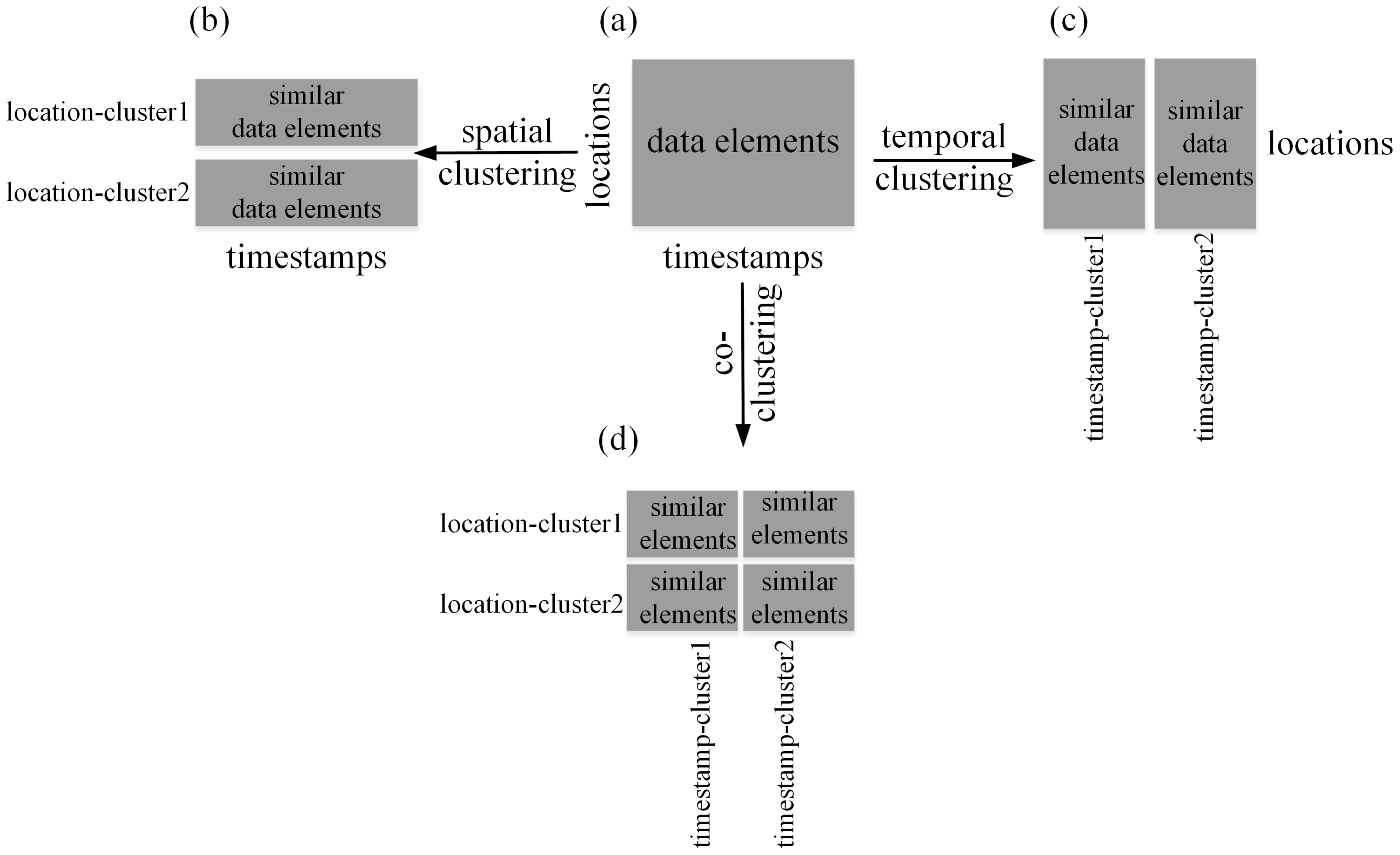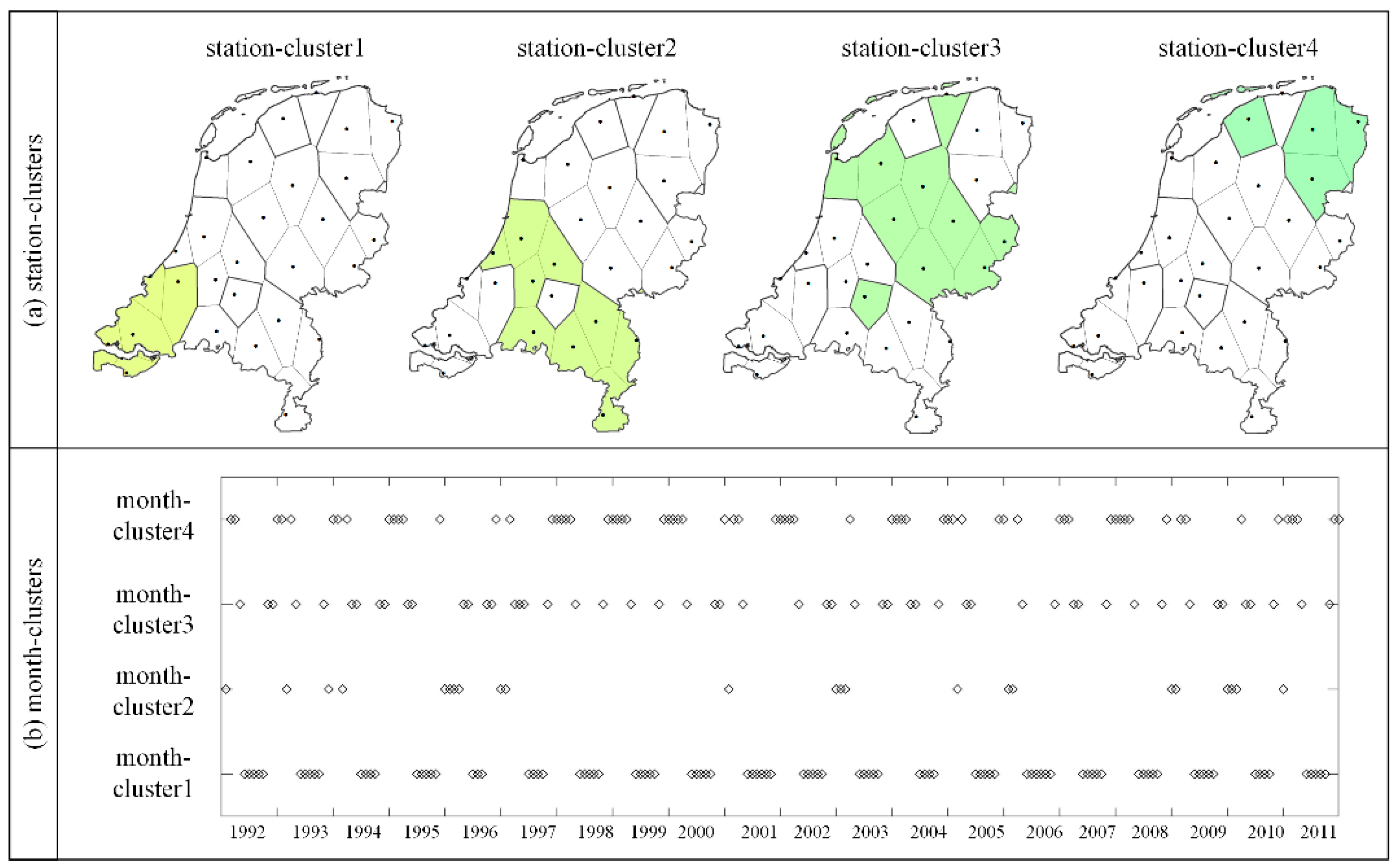Identification of Co-Clusters with Coherent Trends in Geo-Referenced Time Series
Abstract
:1. Introduction
2. Data and Methods
2.1. Data
2.2. Bregman Co-Clustering Algorithm with Minimum Sum-Squared Residue (BCC_MSSR)
3. Results and Discussion
3.1. Spatio-Temporal Co-Clusters with Coherent Trends
3.2. Regional Coherent Spatio-Temporal Patterns in Dutch Monthly Temperature Series
3.3. Comparisons of Co-Clusters with Coherent Trends and Those with Similar Values
4. Conclusions
Funding
Conflicts of Interest
References
- Ribeiro de Almeida, D.; de Souza Baptista, C.; Gomes de Andrade, F.; Soares, A. A survey on big data for trajectory analytics. ISPRS Int. J. Geo-Inf. 2020, 9, 88. [Google Scholar] [CrossRef] [Green Version]
- Li, Z.; Yang, C.; Liu, K.; Hu, F.; Jin, B. Automatic Scaling Hadoop in the Cloud for Efficient Process of Big Geospatial Data. ISPRS Int. J. Geo-Inf. 2016, 5, 173. [Google Scholar] [CrossRef] [Green Version]
- Li, Z.; Tang, W.; Huang, Q.; Shook, E.; Guan, Q. Introduction to Big Data Computing for Geospatial Applications. ISPRS Int. J. Geo-Inf. 2020, 9, 487. [Google Scholar] [CrossRef]
- Shekhar, S.; Jiang, Z.; Ali, R.Y.; Eftelioglu, E.; Tang, X.; Gunturi, V.M.V.; Zhou, X. Spatiotemporal Data Mining: A Computational Perspective. ISPRS Int. J. Geo-Inf. 2015, 4, 2306–2338. [Google Scholar] [CrossRef]
- Han, J.; Kamber, M.; Pei, J. Data Mining Concepts and Techniques, 3rd ed.; Morgan Kaufman MIT Press: Cambridge, MA, USA, 2012. [Google Scholar]
- Tatiana, V.L.; Felix, B.; Philipp, R.; Natalia, A.; Gennady, A.; Andreas, K. MobilityGraphs: Visual Analysis of Mass Mobility Dynamics via Spatio-Temporal Graphs and Clustering. IEEE Trans. Vis. Computer Graph. 2016, 22, 11–20. [Google Scholar]
- Lamb, D.S.; Downs, J.; Reader, S. Space-Time Hierarchical Clustering for Identifying Clusters in Spatiotemporal Point Data. ISPRS Int. J. Geo-Inf. 2020, 9, 85. [Google Scholar] [CrossRef] [Green Version]
- Wu, X.; Cheng, C.; Zurita-Milla, R.; Song, C. An overview of clustering methods for geo-referenced time series: From one-way clustering to co- and tri-clustering. Int. J. Geogr. Inf. Sci. 2020, 34, 1822–1848. [Google Scholar] [CrossRef]
- Andrienko, G.; Bremm, S.; Schreck, T.; Von Landesberger, T.; Bak, P.; Keim, D.; Andrienko, N. Space-in-Time and Time-in-Space Self-Organizing Maps for Exploring Spatiotemporal Patterns. Comput. Graph. Forum 2010, 29, 913–922. [Google Scholar] [CrossRef]
- Hagenauer, J.; Helbich, M. Hierarchical self-organizing maps for clustering spatiotemporal data. Int. J. Geogr. Inf. Sci. 2013, 27, 2026–2042. [Google Scholar] [CrossRef]
- Liu, L.; Hu, T.; Bao, S.; Wu, H.; Peng, Z.; Wang, R. The Spatiotemporal Interaction Effect of COVID-19 Transmission in the United States. ISPRS Int. J. Geo-Infation 2021, 10, 387. [Google Scholar] [CrossRef]
- Ahas, R.; Aasa, A.; Silm, S.; Roosaare, J. Seasonal Indicators and Seasons of Estonian Landscapes. Landsc. Res. 2005, 30, 173–191. [Google Scholar] [CrossRef]
- Wu, X.; Zurita-Milla, R.; Kraak, M.-J. Visual discovery of synchronization in weather data at multiple temporal resolutions. Cartograph. J. 2013, 50, 247–256. [Google Scholar] [CrossRef]
- Wu, X.; Zurita-Milla, R.; Kraak, M.-J. Co-clustering geo-referenced time series: Exploring spatio-temporal patterns in Dutch temperature data. Int. J. Geogr. Inf. Sci. 2015, 29, 624–642. [Google Scholar] [CrossRef] [Green Version]
- Wu, X.; Zurita-Milla, R.; Kraak, M.-J. A novel analysis of spring phenological patterns over Europe based on co-clustering. J. Geophys. Res. Biogeosci. 2016, 121, 1434–1448. [Google Scholar] [CrossRef] [Green Version]
- Wu, X.; Cheng, C.; Qiao, C.; Song, C. Spatio-temporal differentiation of spring phenology in China driven by temperatures and photoperiod from 1979 to 2018. Sci. China Earth Sci. 2020, 63, 1485–1498. [Google Scholar] [CrossRef]
- Ullah, S.; Daud, H.; Dass, S.C.; Khan, H.N.; Khalil, A. Detecting space-time disease clusters with arbitrary shapes and sizes using a co-clustering approach. Geospat. Heal. 2017, 12. [Google Scholar] [CrossRef] [Green Version]
- Andreo, V.; Izquierdo-Verdiguier, E.; Zurita-Milla, R.; Rosà, R.; Rizzoli, A.; Papa, A. Identifying Favorable Spatio-Temporal Conditions for West Nile Virus Outbreaks by Co-Clustering of Modis LST Indices Time Series. In Proceedings of the IGARSS 2018—2018 IEEE International Geoscience and Remote Sensing Symposium, Valencia, Spain, 22–27 July 2018; pp. 4670–4673. [Google Scholar]
- Liu, Q.; Zheng, X.; Stanley, H.E.; Xiao, F.; Liu, W. A Spatio-Temporal Co-Clustering Framework for Discovering Mobility Patterns: A Study of Manhattan Taxi Data. IEEE Access 2021, 9, 34338–34351. [Google Scholar] [CrossRef]
- Eisen, M.B.; Spellman, P.T.; Brown, P.O.; Botstein, D. Cluster analysis and display of genome-wide expression patterns. Proc. Natl. Acad. Sci. USA 1998, 95, 14863–14868. [Google Scholar] [CrossRef] [Green Version]
- Kriegel, H.-P.; Kröger, P.; Zimek, A. Clustering high-dimensional data: A survey on subspace clustering, pattern-based clustering, and correlation clustering. ACM Trans. Knowl. Discov. Data 2009, 3, 1. [Google Scholar] [CrossRef]
- Liang, L.; Li, L.; Liu, Q. Precipitation variability in Northeast China from 1961 to 2008. J. Hydrol. 2011, 404, 67–76. [Google Scholar] [CrossRef]
- Alexander, L.V.; Uotila, P.; Nicholls, N. Influence of sea surface temperature variability on global temperature and precipi-tation extremes. J. Geophys. Res. Atmos. 2009, 114, 1–13. [Google Scholar]
- Estay, S.A.; Clavijo-Baquet, S.; Lima, M.; Bozinovic, F. Beyond average: An experimental test of temperature variability on the population dynamics of Tribolium confusum. Popul. Ecol. 2010, 53, 53–58. [Google Scholar] [CrossRef]
- Zanobetti, A.; O’Neill, M.S.; Gronlund, C.J.; Schwartz, J.D. Summer temperature variability and long-term survival among elderly people with chronic disease. Proc. Natl. Acad. Sci. USA 2012, 109, 6608–6613. [Google Scholar] [CrossRef] [PubMed] [Green Version]
- Andresen, M.A.; Malleson, N. Crime seasonality and its variations across space. Appl. Geogr. 2013, 43, 25–35. [Google Scholar] [CrossRef]
- Banerjee, A.; Dhillon, I.; Ghosh, J.; Merugu, S.; Modha, D.S. A generalized maximum entropy approach to bregman co-clustering and matrix approximation. J. Mach. Learn. Res. 2007, 8, 1919–1986. [Google Scholar]
- Cheng, Y.; Church, G.M. Biclustering of expression data. In Proceedings of the Proceedings ISMB 2000, San Diego, CA, USA, 19–23 August 2000; pp. 93–103. [Google Scholar]
- Cho, H.; Dhillon, I.S.; Guan, Y.; Sra, S. Minimum Sum-Squared Residue Co-clustering of Gene Expression Data. In Proceedings of the 2004 SIAM International Conference on Data Mining; Society for Industrial & Applied Mathematics (SIAM), Philadelphia, PA, USA, 22–24 April 2004. [Google Scholar]
- Cho, H.; Dhillon, I. Coclustering of Human Cancer Microarrays Using Minimum Sum-Squared Residue Coclustering. IEEE/ACM Trans. Comput. Biol. Bioinform. 2008, 5, 385–400. [Google Scholar] [CrossRef]
- Yang, J.; Wang, H.; Wang, W.; Yu, P. Enhanced biclustering on expression data. In Proceedings of the Third IEEE Symposium on Bioinformatics and Bioengineering, Bethesda, MD, USA, 12 March 2003; pp. 321–327. [Google Scholar]
- Kluger, Y.; Basri, R.; Chang, J.T.; Gerstein, M. Spectral Biclustering of Microarray Data: Coclustering Genes and Conditions. Genome Res. 2003, 13, 703–716. [Google Scholar] [CrossRef] [Green Version]
- Rathipriya, R.; Thangavel, K.; Bagyamani, J. Binary Particle Swarm Optimization based Biclustering of Web Usage Data. Int. J. Comput. Appl. 2011, 25, 43–49. [Google Scholar] [CrossRef]
- Rousseeuw, P.J. Silhouettes: A graphical aid to the interpretation and validation of cluster analysis. J. Comput. Appl. Math. 1987, 20, 53–65. [Google Scholar] [CrossRef] [Green Version]
- Lewis, J.M.; Ackerman, M.; Sa, V.R.D. Human cluster evaluation and formal quality measures: A comparative study. In Proceedings of the 34th Conference of the Cognitive Science Society (CogSci), Sapporo, Japan, 1–4 August 2012; Volume 34, pp. 1870–1875. [Google Scholar]
- Wu, X.; Zurita-Milla, R.; Verdiguier, E.I.; Kraak, M.-J. Triclustering Georeferenced Time Series for Analyzing Patterns of Intra-Annual Variability in Temperature. Ann. Am. Assoc. Geogr. 2017, 108, 71–87. [Google Scholar] [CrossRef] [Green Version]
- Visser, H. The Significance of Climate Change in the Netherlands. An Analysis of Historical and Future Trends (1901–2020) in Weather Conditions, Weather Extremes and Temperature-Related Impacts. MNP Rep. 2005, 550002007. Available online: https://www.pbl.nl/en/publications/The_significance_of_climate_change_in_the_Netherlands (accessed on 5 January 2022).
- Garssen, J.; Harmsen, C.; De Beer, J. The effect of the summer 2003 heat wave on mortality in the Netherlands. Eurosurveillance 2005, 10, 13–14. [Google Scholar] [CrossRef]
- Fischer, P.H.; Marra, M.; Ameling, C.B.; Janssen, N.; Cassee, F.R. Trends in relative risk estimates for the association between air pollution and mortality in The Netherlands, 1992–2006. Environ. Res. 2011, 111, 94–100. [Google Scholar] [CrossRef] [PubMed]
- Daniels, E.E.; Lenderink, G.; Hutjes, R.W.A.; Holtslag, A.A.M. Spatial precipitation patterns and trends in The Netherlands during 1951–2009. Int. J. Clim. 2014, 34, 1773–1784. [Google Scholar] [CrossRef]
- van Vliet, A.J.H.; Overeem, A.; De Groot, R.S.; Jacobs, A.F.G.; Spieksma, F.T.M. The influence of temperature and climate change on the timing of pollen release in the Netherlands. Int. J. Clim. 2002, 22, 1757–1767. [Google Scholar] [CrossRef]
- Schaap, B.F.; Blom-Zandstra, M.; Hermans, C.M.L.; Meerburg, B.; Verhagen, J. Impact changes of climatic extremes on arable farming in the north of the Netherlands. Reg. Environ. Chang. 2011, 11, 731–741. [Google Scholar] [CrossRef] [Green Version]
- Shao, J.; Li, Y.; Ni, J. The characteristics of temperature variability with terrain, latitude and longitude in Sichuan-Chongqing Region. J. Geogr. Sci. 2012, 22, 223–244. [Google Scholar] [CrossRef]
- Grubesic, T.H.; Wei, R.; Murray, A.T. Spatial Clustering Overview and Comparison: Accuracy, Sensitivity, and Computational Expense. Ann. Assoc. Am. Geogr. 2014, 104, 1134–1156. [Google Scholar] [CrossRef]









Publisher’s Note: MDPI stays neutral with regard to jurisdictional claims in published maps and institutional affiliations. |
© 2022 by the author. Licensee MDPI, Basel, Switzerland. This article is an open access article distributed under the terms and conditions of the Creative Commons Attribution (CC BY) license (https://creativecommons.org/licenses/by/4.0/).
Share and Cite
Wu, X. Identification of Co-Clusters with Coherent Trends in Geo-Referenced Time Series. ISPRS Int. J. Geo-Inf. 2022, 11, 134. https://doi.org/10.3390/ijgi11020134
Wu X. Identification of Co-Clusters with Coherent Trends in Geo-Referenced Time Series. ISPRS International Journal of Geo-Information. 2022; 11(2):134. https://doi.org/10.3390/ijgi11020134
Chicago/Turabian StyleWu, Xiaojing. 2022. "Identification of Co-Clusters with Coherent Trends in Geo-Referenced Time Series" ISPRS International Journal of Geo-Information 11, no. 2: 134. https://doi.org/10.3390/ijgi11020134




